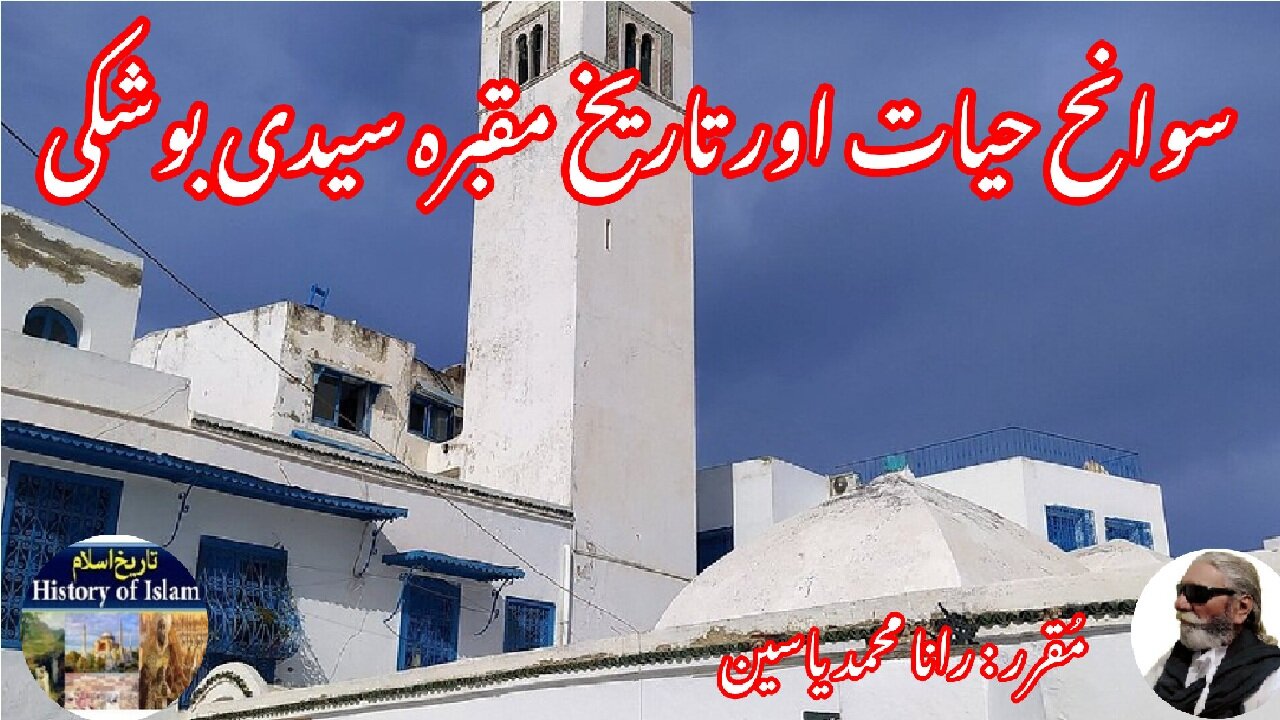Premium Only Content

Biography of Sidi Boushaki | सिदी बौशाकी | سیدی بوشکی کی سوانح عمری اور ان کے مزار کی تاریخ
@islamichistory813 #sufisaint #culturalheritage #biography #sidiboushaki #islamicmysticism #islamicphilosophy #shrine #historicalfigures
Biography of Sidi Boushaki and the history of his shrine
Dekhti Aankhooon aur sountay kaanoon ko Asslamoalaikum, sisters, brothers friends and elders, in informative series videos of Islamic ascolars, sufisaints, cultural heritages, islamic philosophys, islamic mysticisms and historical figures. today we are describing biography of Sidi Boushaki and the history of his shrine.
Sidi Boushaki, born Ibrahim Ibn Faïd Ez-Zaouaoui in 1394 CE (796 AH) in the village of Soumaa near Thenia, Algeria, was a distinguished Maliki theologian, jurist, linguist, and Sufi scholar. His lineage traces back to the Igawawen tribe, known for its deep-rooted Islamic scholarship and spiritual heritage.
Raised in a spiritually rich environment, Sidi Boushaki began his education in his native village, Thala Oufella (Soumâa), in 1398 CE. Demonstrating an early aptitude for Islamic sciences, he traveled to Béjaïa in 1404 CE to further his studies. Béjaïa, a prominent center of learning and Sufism in the Maghreb, provided him with the opportunity to study under renowned scholars, including Sidi Abdelhaq El Ghobrini, a respected theologian from Kabylia.
In 1415 CE, Sidi Boushaki journeyed to Tunis to deepen his understanding of the Maliki school of jurisprudence. There, he studied Quranic exegesis (tafsir) under Judge Abu Abdallah Al Kalchani and received instruction in Maliki fiqh from Yaakub Ez-Zaghbi. He also studied the foundational principles of Islam under Abdelwahed Al Fariani. His pursuit of knowledge led him to Mecca for pilgrimage and further studies, followed by a sojourn in Damascus, where he attended the teachings of Imam Ibn al-Jazari, an eminent scholar in the sciences of the Quran.
Upon returning to Algeria, Sidi Boushaki settled in Constantine around 1423 CE. There, he immersed himself in teaching and scholarly activities, focusing on various Islamic sciences, including theology (Aqidah), logic, prose, verse, and jurisprudence. He studied under prominent scholars such as Abu Zeid Abderrahmane, known as "El Bez," and the esteemed Maghreb scholar Ibn Marzuq El Khatib.
Sidi Boushaki's scholarly endeavors were not confined to teaching; he also authored several works, notably a poem elucidating the rules of grammatical parsing, reflecting his deep understanding of the Arabic language and its intricacies.
In the later years of his life, Sidi Boushaki returned to his native Kabylia and established a zawiya (Islamic religious school) in Thala Oufella (Soumâa). This institution became a beacon of intellectual and spiritual influence throughout Lower Kabylia. Operating under the Qadiriyya Sufi order, the zawiya played a pivotal role in educating and guiding disciples (murids) in Islamic sciences, Quranic memorization, and Sufi practices. For three centuries, it remained a center of religious learning and spiritual development until the Rahmaniyya Sufi order gained prominence in the region.
Sidi Boushaki passed away in 1453 CE (857 AH) and was buried near his zawiya in the Thenia Mountains. His legacy endures through his contributions to Islamic scholarship, the students he mentored, and the spiritual institution he founded, which continued to influence the religious landscape of Algeria for centuries.
The shrine of Sidi Boushaki, located in Soumâa, Thenia, Algeria, stands as a testament to his enduring spiritual and scholarly legacy. Over the centuries, it has attracted visitors seeking spiritual solace, blessings, and a connection to the rich Islamic heritage of the region. The shrine, encompassing his tomb and the adjacent zawiya, has been a focal point for religious education, Sufi gatherings, and community events. Its historical significance is intertwined with the spread of Sufism in Algeria, particularly the Qadiriyya order, which Sidi Boushaki ardently propagated.
Throughout history, the shrine has undergone various renovations and restorations, reflecting the community's dedication to preserving the sanctity and heritage of the site. It has served not only as a place of worship but also as a center for the dissemination of Islamic knowledge, hosting scholars and students dedicated to the study of the Quran, Hadith, and Maliki jurisprudence. The architectural features of the shrine, characteristic of North African Islamic design, include intricate calligraphy, geometric patterns, and serene courtyards conducive to reflection and study.
In contemporary times, the shrine continues to be a symbol of spiritual heritage and a site of cultural tourism, attracting visitors from various parts of Algeria and beyond. Efforts to protect and promote the Algerian Islamic reference, as exemplified by Sidi Boushaki's teachings, underscore the shrine's role in fostering a sense of identity and continuity within the community.
Sidi Boushaki's life and legacy are emblematic of the rich tapestry of Islamic scholarship and Sufi tradition in North Africa. His contributions as a theologian, jurist, linguist, and Sufi continue to inspire scholars and spiritual seekers. The shrine and zawiya he established remain enduring symbols of his commitment to the dissemination of Islamic knowledge and the spiritual development of his community. Through the preservation of his teachings and the institutions he founded, Sidi Boushaki's impact on the religious and cultural landscape of Algeria persists to this day.
With this, we seek your permission until tomorrow, tomorrow we will describe the biography of Seyid Ali Imadaddin Nasimi and the history of his Shrine. Allah Hafiz.
==========================
-
 6:21
6:21
ISLAMIC HISTORY
20 hours agoNizamuddin Auliya | निज़ामुद्दीन औलिया | نظام الدین اولیاء کی سوانح حیات اور ان کے مزار کی تاریخ
7 -
 16:56
16:56
Clownfish TV
1 day agoDisney's DEATH by Tariffs? They DEPEND on China!
15.2K9 -
 11:30
11:30
IsaacButterfield
1 day ago $0.74 earnedThis Hate Speech Law Is RACIST To White People.
10.5K24 -
 14:57
14:57
BEK TV
1 day agoEP 6 - DUNSEITH DECLASSIFIED: RESPECTED NATIONAL MEDIA LEGAL EXPERT WEIGHS IN
17.3K -
 29:59
29:59
The Brett Cooper Show
3 days ago $15.32 earnedHow This Sparked A MASSIVE Parenting Debate Online | Episode 20
57.7K95 -
 17:55
17:55
DeVory Darkins
18 hours ago $22.55 earnedCNN crushed by pronouns as Trump scores HUGE VICTORY
83.9K81 -
 2:48:33
2:48:33
Barry Cunningham
19 hours agoWATCH LIVE: MY INTERVIEW WITH LARA TRUMP! AND TODAY'S NEWS ABOUT DEMOCRATS HATING AMERICA!
122K28 -
 3:12:15
3:12:15
TimcastIRL
12 hours agoLiberals BLAME TRUMP For NYC Tourist Helicopter Crash After Tragic Accident | Timcast IRL
284K188 -
 1:16:36
1:16:36
Glenn Greenwald
15 hours agoGlenn Takes Your Questions: On Banning Candidates in the Democratic World, Expanding Executive Power, and Trump's Tariffs | SYSTEM UPDATE #437
141K55 -
 40:09
40:09
Friday Beers
13 hours ago $7.13 earnedWii Golf Gets Heated: Friday Beers vs Full Squad Gaming
69.1K1